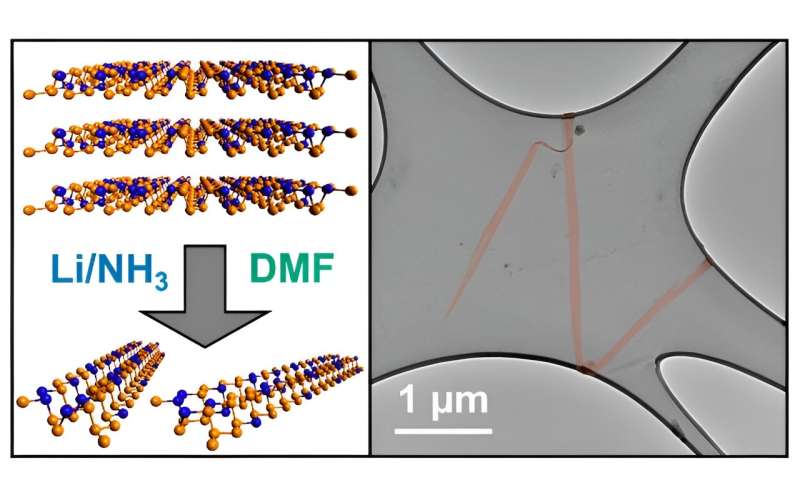This article has been reviewed according to Science X's editorial process and policies. Editors have highlighted the following attributes while ensuring the content's credibility:
fact-checked
peer-reviewed publication
trusted source
proofread
One-atom-thick phosphorus/arsenic alloy ribbons could improve batteries, solar cells and sensors

Researchers at UCL have created one-atom-thick ribbons made of phosphorus alloyed with arsenic that could dramatically improve the efficiency of devices such as batteries, supercapacitors and solar cells.
The research team discovered phosphorus nanoribbons in 2019. The "wonder material," predicted to revolutionize devices ranging from batteries to biomedical sensors, has since been used to increase lithium-ion battery lifetimes and solar cell efficiencies.
However, phosphorus-only materials do not conduct electricity very well, hindering their usage for certain applications.
In the new study, published in the Journal of the American Chemical Society, the researchers created nanoribbons made of phosphorus and tiny amounts of arsenic, which they found were able to conduct electricity at temperatures above -140°C, while retaining the highly useful properties of the phosphorus-only ribbons.
Senior author Dr. Adam Clancy (UCL Chemistry) said, "Early experimental work has already shown the remarkable promise of phosphorus nanoribbons, created for the first time by our UCL team in 2019. In 2021, for instance, it was shown that adding the nanoribbons as a layer to perovskite solar cells allowed the cells to harness more energy from the sun.
"Our latest work in alloying phosphorus nanoribbons with arsenic opens up further possibilities—in particular, improving energy storage of batteries and supercapacitors, and enhancing near-infrared detectors used in medicine.
"The arsenic-phosphorus ribbons have also turned out to be magnetic which we believe comes from atoms along the edge, which makes them potentially of interest for quantum computers too.
"More widely, the study shows that alloying is a powerful tool for controlling the properties and thus applications and potential of this growing nanomaterial family." The researchers say same technique could be used to make alloys combining phosphorus with other elements such as selenium or germanium.
To be used as an anode material in lithium-ion or sodium-ion batteries, phosphorus nanoribbons currently would need to be mixed with a conductive material like carbon. By adding arsenic, the carbon filler is no longer necessary and can be removed, enhancing the amount of energy the battery can store and the speed at which it can be charged and discharged.
In solar cells, meanwhile, arsenic-phosphorus nanoribbons can further improve the flow of charge through the devices, enhancing the cells' efficiency.
The arsenic-phosphorus ribbons created by the research team were typically a few layers high, several micrometers long and tens of nanometers wide. They were made by mixing crystals formed from sheets of phosphorus and arsenic with lithium dissolved in liquid ammonia at -50°C. (After 24 hours, the ammonia is removed and replaced with an organic solvent.) The sheets' atomic structure means the lithium ions can travel in one direction only, not laterally, causing cracking that creates the ribbons.
A key characteristic of the nanoribbons is that they also have extremely high "hole mobility." Holes are the opposite partners to electrons in electrical transport, so improving their mobility (a measure of the speed at which they move through the material) helps electrical current move more efficiently.
The nanoribbons could be produced at scale in a liquid that could then be used to apply them in volume at low cost for different applications.
Phosphorus nanoribbons were discovered at UCL by an interdisciplinary team led by Professor Chris Howard (UCL Physics & Astronomy). Since the isolation of 2-dimensional phosphorene sheets in 2014, more than 100 theoretical studies had predicted new and exciting properties that could emerge by producing narrow ribbons of this material.
More information: Feng Fei Zhang et al, Production of Magnetic Arsenic–Phosphorus Alloy Nanoribbons with Small Band Gaps and High Hole Conductivities, Journal of the American Chemical Society (2023). DOI: 10.1021/jacs.3c03230
Journal information: Journal of the American Chemical Society
Provided by University College London




















